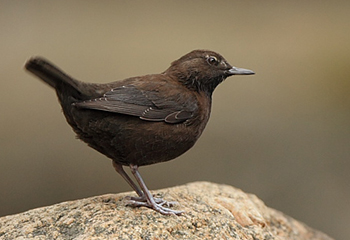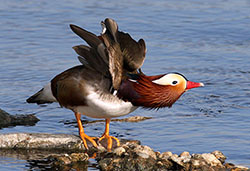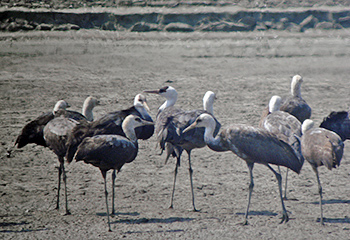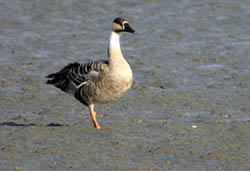
Korea’s rivers are alive. They support many specialised species. They connect wetlands, one to another, allowing water and wetland species to move to new areas. Natural stretches of river have a distinctive “ecological character”. They have a very important role in naturally improving water quality, in naturally reducing the dangers of flooding. Natural stretches of river are often extremely beautiful. Their beauty is part of the culture and heritage and image of the nation.








Several Korean bird species are dependent on natural, free-flowing stretches of rivers. These species are a part of the “ecological character” of rivers.
In the mountains, where the rivers flow fast, there are nesting Brown Dippers Cinclus pallasii and Grey Wagtails Motacilla cinerea. As the rivers become wider and slower, there are Mandarin Duck Aix galericulata, and in the quietest areas, Scaly-sided Merganser Mergus squamatus, a globally Endangered species with a world population of only around 1800. As rivers reach their flood-plains, shingle-banks and sand-banks are used by nesting Long-billed Plover Charadrius placidus and at Gumi on the Nakdong River, by roosting Hooded Crane Grus monacha, a species with a world population of just 10,000. Becoming wider and shallower, the rivers eventually form estuaries that are extremely important for an even wider diversity of bird species, including shorebirds and the globally Endangered Swan Goose Anser cygnoides and Black-faced Spoonbill Platalea minor. These bird species, and other species like them, are both part of and also depend on the ecological character of natural rivers. They are valuable bio-indicators, indicating healthy and important river-wetlands. They are part of the natural culture of the nation and many of them are listed as National Natural Monuments.
The Republic of Korea has already passed several national laws and signed international agreements making clear that as a nation we understand the value of these species, and the value of our rivers. We have promised as a nation to conserve biodiversity and rivers and other wetlands, and our nation is bound by these agreements to do so. Our nation is a signatory to the Convention on Biological Diversity, and is an active member of the United Nations. As all member nations do, we have accepted the obligations and benefits of that membership. As a nation we have, for example, agreed to work to reduce the rate of biodiversity loss by 2010 – agreed to in 2002 by the World Summit on Sustainable Development, and listed as Goal 7 Target 2 of the United Nation’s Millennium Development Goals.
As an active member of the Ramsar Convention, even hosting the most recent triennial Ramsar Convention conference (Changwon, October-November 2008), the government of the Republic of Korea has, on our behalf, agreed publicly, nationally and internationally, to conserve, to use wisely, the nation’s wetlands and wetland biodiversity. Our membership of the Ramsar convention means that, as a nation, we have agreed to include the conservation of wetlands in our national planning policy, and we have agreed to plan for the wise use of all wetlands (Ramsar, Article 3.1). We have agreed that wise use of wetlands requires conserving their ecological character (Ramsar Resolution 9.1), and that “ecological character” means the “combination of the ecosystem components, processes and benefits/services that characterise the wetland” (Ramsar Resolution 9.1, Annex A). We have agreed, as a nation, that conservation of wetlands requires good planning and wise use at the river catchment level (Ramsar Resolution 10.19). As a nation, we have also demonstrated our support for the development of rigorous and scientific environmental impact assessments and the need for improved assessment of biological diversity of wetlands, including rivers (Ramsar Resolution 10.17).
Through existing national conservation laws and these international agreements, the Republic of Korea has agreed to protect the ecological character of our rivers. It has made a public promise to keep our natural rivers natural, and our living rivers alive.
As an apolitical organisation working for the conservation of birds and their habitats, Birds Korea is therefore puzzled by and very deeply concerned by recent announcements in support of the “refurbishment” of four, or now perhaps five, of the nation’s major rivers. These announcements appear not to have included any statements of acceptance of the clear (and legally-binding) obligations held under the Ramsar Convention and the Convention on Biological Diversity. Rather, supporters have tried to claim that the nation’s main rivers will actually be improved through the loss of their present ecological character.
In respect to the Four River Refurbishment Plan, Birds Korea would like to ask developers:
The Plan apparently includes measures to prevent pollution from entering the rivers. Do these measures include the creation of wetlands to act as semi-natural water treatment facilities? With less pollution entering them, why would the rivers in their natural state be unable to maintain good water quality?
Many of the rivers are naturally shallow. What is the purpose of making the rivers deeper than their natural depth, especially as such areas will then need constant and expensive re-dredging? If it is so that the rivers can carry more water, is it possible to widen them instead?
Has analysis been conducted to assess the benefits of natural river-banks when compared to concreted river-banks? International experience suggests that vegetated river-banks, supported where necessary by artificial structures, will be strong, and cheaper to maintain than concreted river-banks, with more value for biodiversity, recreation and environmental education.
To store rain water and to help reduce downstream flooding, there is a need to identify and set-aside large, flood-prone areas that can be restored to natural flood-plain wetland. Did the project assessment team consider this option? What were the methods and the results of their research? Have these studies been published and made available, in line with Ramsar guidance, so that they can be reviewed by independent wetland specialists?
It is clear that decision-makers that support the river refurbishment project in its present form have up to now been very poorly advised. We wish, most respectfully, to direct planners and developers and decision-makers to the expert guidance provided by the Ramsar Convention. We wish to inform all concerned that the wider scientific and conservation community already understand that massive construction projects as proposed will cause significant and long-term damage to the ecological character of several of the nation’s major rivers. We believe that many in the general public also already understand this. Damage will be caused by the removal of natural river-beds and river-edges, by the restriction of the movement of water through the construction of dams and weirs, and by greatly increased disturbance. These projects will cause further declines in already threatened species. These declines will be measurable (through survey work), and will be of concern to people in Korea and throughout the world. During a period of global economic slowdown, Birds Korea is further concerned that unsustainable development of this kind will both damage the national natural heritage and also the international image of the Republic of Korea.
Birds Korea therefore joins with others, throughout Korea and the rest of the world, in respectfully asking for an immediate suspension of the very poorly-advised “Four Main Rivers Refurbishment Plan”. We believe that there is an urgent need for a full and independent assessment of the Plan’s impacts, on biodiversity, ecological character of rivers, wise use of wetlands, and the national interest.
The Rivers Are Alive – Please Let Them Remain So.
Better than the Korean Grand Canal Plan?
Restoring Rivers to Help Revitalize Economy [February 11, 2009]
Seoul-Incheon Canal Construction Kicks Off [February 11, 2009]
'New Green Deal' or 'Grander Canal' [January 30, 2009]
Gov't starts 'four major rivers restoration project' [February 06, 2009]
'Green New Deal' is keyword for Korea [January 16, 2009]
Gov't to set out master plan for four river project in May [January 15, 2009]
Project details: How can four major rivers be restored? [January 15, 2009]
More Thorough Work Is Needed on the River Project [January 6, 2009]
Cultural policy for 2009 to go green [December 29, 2008]
Four major rivers to enjoy better environments by 2011 [December 16, 2008]



